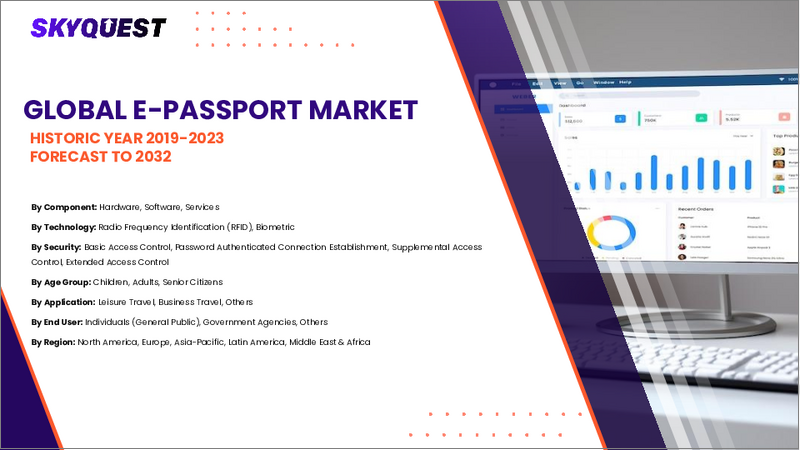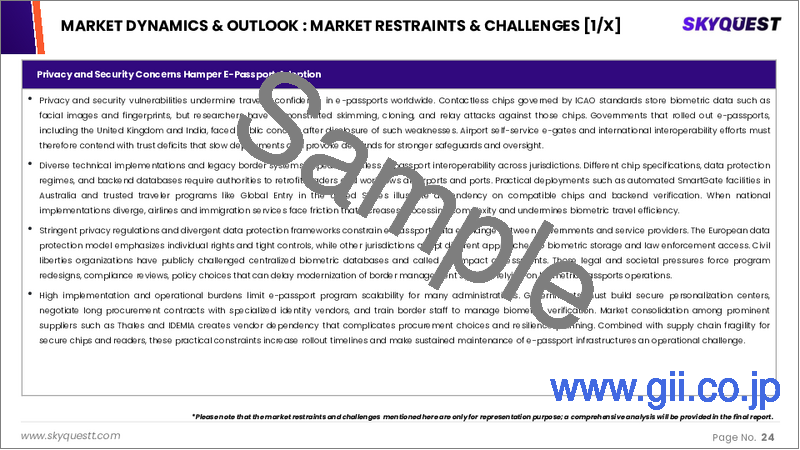|
|
市場調査レポート
商品コード
1722232
電子パスポートの市場規模、シェア、成長分析、コンポーネント別、技術別、セキュリティ別、年齢層別、用途別、エンドユーザー別、地域別 - 産業予測 2025~2032年E-Passport Market Size, Share, and Growth Analysis, By Component (Hardware, Software), By Technology (Radio Frequency Identification, Biometric), By Security, By Age group, By Application, By End User, By Region - Industry Forecast 2025-2032 |
||||||
|
|||||||
| 電子パスポートの市場規模、シェア、成長分析、コンポーネント別、技術別、セキュリティ別、年齢層別、用途別、エンドユーザー別、地域別 - 産業予測 2025~2032年 |
|
出版日: 2025年05月03日
発行: SkyQuest
ページ情報: 英文 192 Pages
納期: 3~5営業日
|
全表示
- 概要
- 目次
電子パスポートの世界市場規模は2023年に324億2,000万米ドルとなり、予測期間(2025-2032年)のCAGRは12.6%で、2024年の365億1,000万米ドルから2032年には943億5,000万米ドルに成長する見通しです。
電子パスポート市場は、セキュリティ要求の高まり、技術の進歩、より安全で効率的な渡航書類の世界の推進により、大きく拡大しています。各国政府は、国境警備の強化、不正行為の削減、旅行者の利便性向上のため、電子パスポートの採用を加速させています。海外旅行が増加し続ける中、e-パスポートと統合された生体認証システムに対する需要が急増しています。RFIDチップ、顔認識、虹彩スキャンなどのデジタルセキュリティの革新は、この市場の発展に不可欠です。生体認証登録システムの台頭とサイバーセキュリティへの関心の高まりが、特に海外渡航の多い国々での電子パスポートの普及をさらに後押ししています。国際民間航空機関(ICAO)によって設定されたような国際基準に準拠することで、eパスポートは国境を越えて互換性を保つことができます。
目次
イントロダクション
- 調査の目的
- 調査範囲
- 定義
調査手法
- 情報調達
- 二次と一次データの方法
- 市場規模予測
- 市場の前提条件と制限
エグゼクティブサマリー
- 世界市場の見通し
- 供給と需要の動向分析
- セグメント別機会分析
市場力学と見通し
- 市場概要
- 市場規模
- 市場力学
- 促進要因と機会
- 抑制要因と課題
- ポーターの分析
主な市場の考察
- 重要成功要因
- 競合の程度
- 主な投資機会
- 市場エコシステム
- 市場の魅力指数(2024年)
- PESTEL分析
- マクロ経済指標
- バリューチェーン分析
- 技術分析
- ケーススタディ
- 規制分析
電子パスポート市場規模:コンポーネント別& CAGR(2025-2032)
- 市場概要
- ハードウェア
- マイクロプロセッサ
- チップス
- その他
- ソフトウェア
- サービス
電子パスポート市場規模:技術別& CAGR(2025-2032)
- 市場概要
- 無線周波数識別(RFID)
- 生体認証
電子パスポート市場規模:セキュリティ別& CAGR(2025-2032)
- 市場概要
- 基本的なアクセス制御
- パスワード認証による接続の確立
- 補足アクセス制御
- 拡張アクセス制御
電子パスポート市場規模:年齢層別& CAGR(2025-2032)
- 市場概要
- 子供
- 大人
- シニア
電子パスポート市場規模:用途別& CAGR(2025-2032)
- 市場概要
- レジャー旅行
- ビジネス旅行
- その他
電子パスポート市場規模:エンドユーザー別& CAGR(2025-2032)
- 市場概要
- 個人(一般の方)
- 政府機関
- その他
電子パスポート市場規模:地域別& CAGR(2025-2032)
- 北米
- 米国
- カナダ
- 欧州
- ドイツ
- スペイン
- フランス
- 英国
- イタリア
- その他欧州地域
- アジア太平洋地域
- 中国
- インド
- 日本
- 韓国
- その他アジア太平洋地域
- ラテンアメリカ
- ブラジル
- その他ラテンアメリカ地域
- 中東・アフリカ
- GCC諸国
- 南アフリカ
- その他中東・アフリカ
競合情報
- 上位5社の比較
- 主要企業の市場ポジショニング(2024年)
- 主な市場企業が採用した戦略
- 最近の市場動向
- 企業の市場シェア分析(2024年)
- 主要企業の企業プロファイル
- 企業の詳細
- 製品ポートフォリオ分析
- 企業のセグメント別シェア分析
- 収益の前年比比較(2022-2024年)
主要企業プロファイル
- 4G Identity Solutions
- CARDLOGIX CORPORATION
- Eastcompeace Technology Co., Ltd.
- Entrust Corporation
- HID Global Corporation
- Muhlbauer Group
- Infineon Technologies AG
- Thales Group
- 3M
- IDEMIA
結論と提言
Global E-Passport Market size was valued at USD 32.42 Billion in 2023 and is poised to grow from USD 36.51 Billion in 2024 to USD 94.35 Billion by 2032, growing at a CAGR of 12.6% during the forecast period (2025-2032).
The e-passport market is experiencing significant expansion, driven by heightened security demands, technological advancements, and a global push for more secure and efficient travel documentation. Governments are increasingly adopting e-passports to bolster border security, reduce fraud, and enhance the traveler experience. As international travel continues to grow, there is a surging demand for biometric identification systems integrated with e-passports. Innovations in digital security, such as RFID chips, facial recognition, and iris scanning, have been vital in advancing this market. The rise of biometric enrollment systems and a greater focus on cybersecurity have further supported the widespread adoption of e-passports, particularly in nations with high international travel volumes. Compliance with international standards, like those set by the International Civil Aviation Organization (ICAO), ensures that e-passports remain compatible across borders.
Top-down and bottom-up approaches were used to estimate and validate the size of the Global E-Passport market and to estimate the size of various other dependent submarkets. The research methodology used to estimate the market size includes the following details: The key players in the market were identified through secondary research, and their market shares in the respective regions were determined through primary and secondary research. This entire procedure includes the study of the annual and financial reports of the top market players and extensive interviews for key insights from industry leaders such as CEOs, VPs, directors, and marketing executives. All percentage shares split, and breakdowns were determined using secondary sources and verified through Primary sources. All possible parameters that affect the markets covered in this research study have been accounted for, viewed in extensive detail, verified through primary research, and analyzed to get the final quantitative and qualitative data.
Global E-Passport Market Segments Analysis
The global E-Passport market is segmented on the basis of Component, Technology, Security, and region. By component, the market is segmented into Hardware (Microprocessor, Chips, Others), Software, and Services. By Technology, the market is segmented into Radio Frequency Identification (RFID), and Biometric. Based on Security, the market is segmented into Basic Access Control, Password Authenticated Connection Establishment, Supplemental Access Control, and Extended Access Control. By Age group, the market is segmented into Children, Adults, and Seniors. By Application, the market is segmented into Leisure Travel, Business Travel, and Others. By End User, the market is segmented into Individuals (General Public), Government Agencies, and Others. By region, the market is segmented into North America, Europe, Asia Pacific, the Middle East and Africa, and Latin America.
Driver of the Global E-Passport Market
The global e-passport market is being significantly driven by heightened security threats, including terrorism, identity theft, and illegal immigration. In response, governments prioritize border security to protect citizens and international visitors by integrating advanced security measures into travel documentation. E-passports enhance safety through the incorporation of biometric elements, such as fingerprints, facial recognition, and RFID technology, making them more secure, difficult to forge, and easily identifiable. Countries like the U.S. and the U.K. have widely embraced biometric e-passport technology to enhance their border management systems and mitigate fraud risk. The capability for real-time data verification fosters efficient immigration processing while reinforcing security protocols. Consequently, the rising apprehension surrounding identity theft and document fraud compels nations to adopt e-passports, aligning with global standards and propelling market growth.
Restraints in the Global E-Passport Market
One key market restraint for the global e-passport market is the rising concerns over data security and privacy. As governments and organizations implement e-passports that utilize biometric data, the potential risks of data breaches and identity theft become more pronounced. High-profile cyberattacks and increasing awareness among the public about privacy implications can lead to reluctance in adopting these technological solutions. Furthermore, stringent regulations regarding data protection and the need for compliance with international standards may hinder the speed and scalability of e-passport deployments, ultimately affecting market growth and consumer trust in these digital identification systems.
Market Trends of the Global E-Passport Market
The global e-passport market is witnessing a significant trend towards the integration of blockchain technology, which enhances data security and integrity. As governments respond to rising concerns over data breaches and identity theft, the implementation of decentralized and tamper-proof ledgers offers a robust solution for safeguarding personal and biometric information. Countries such as France are piloting blockchain-driven e-passport systems, while the United Kingdom and Germany are exploring similar technologies to streamline airport operations and improve processes. This adoption not only fortifies digital identity management but also positions blockchain as a transformative force within the e-passport landscape, shaping its future trajectory.
Table of Contents
Introduction
- Objectives of the Study
- Scope of the Report
- Definitions
Research Methodology
- Information Procurement
- Secondary & Primary Data Methods
- Market Size Estimation
- Market Assumptions & Limitations
Executive Summary
- Global Market Outlook
- Supply & Demand Trend Analysis
- Segmental Opportunity Analysis
Market Dynamics & Outlook
- Market Overview
- Market Size
- Market Dynamics
- Drivers & Opportunities
- Restraints & Challenges
- Porters Analysis
- Competitive rivalry
- Threat of substitute
- Bargaining power of buyers
- Threat of new entrants
- Bargaining power of suppliers
Key Market Insights
- Key Success Factors
- Degree of Competition
- Top Investment Pockets
- Market Ecosystem
- Market Attractiveness Index, 2024
- PESTEL Analysis
- Macro-Economic Indicators
- Value Chain Analysis
- Technology Analysis
- Case Studies
- Regulatory Analysis
Global E-Passport Market Size by Component & CAGR (2025-2032)
- Market Overview
- Hardware
- Microprocessor
- Chips
- Others
- Software
- Services
Global E-Passport Market Size by Technology & CAGR (2025-2032)
- Market Overview
- Radio Frequency Identification (RFID)
- Biometric
Global E-Passport Market Size by Security & CAGR (2025-2032)
- Market Overview
- Basic Access Control
- Password Authenticated Connection Establishment
- Supplemental Access Control
- Extended Access Control
Global E-Passport Market Size by Age Group & CAGR (2025-2032)
- Market Overview
- Children
- Adults
- Seniors
Global E-Passport Market Size by Application & CAGR (2025-2032)
- Market Overview
- Leisure Travel
- Business Travel
- Others
Global E-Passport Market Size by End-User & CAGR (2025-2032)
- Market Overview
- Individuals (General Public)
- Government Agencies
- Others
Global E-Passport Market Size & CAGR (2025-2032)
- North America (By Component, By Technology, By Security, By Age Group, By Application, By End-User)
- US
- Canada
- Europe (By Component, By Technology, By Security, By Age Group, By Application, By End-User)
- Germany
- Spain
- France
- UK
- Italy
- Rest of Europe
- Asia Pacific (By Component, By Technology, By Security, By Age Group, By Application, By End-User)
- China
- India
- Japan
- South Korea
- Rest of Asia-Pacific
- Latin America (By Component, By Technology, By Security, By Age Group, By Application, By End-User)
- Brazil
- Rest of Latin America
- Middle East & Africa (By Component, By Technology, By Security, By Age Group, By Application, By End-User)
- GCC Countries
- South Africa
- Rest of Middle East & Africa
Competitive Intelligence
- Top 5 Player Comparison
- Market Positioning of Key Players, 2024
- Strategies Adopted by Key Market Players
- Recent Developments in the Market
- Company Market Share Analysis, 2024
- Company Profiles of All Key Players
- Company Details
- Product Portfolio Analysis
- Company's Segmental Share Analysis
- Revenue Y-O-Y Comparison (2022-2024)
Key Company Profiles
- 4G Identity Solutions
- Company Overview
- Business Segment Overview
- Financial Updates
- Key Developments
- CARDLOGIX CORPORATION
- Company Overview
- Business Segment Overview
- Financial Updates
- Key Developments
- Eastcompeace Technology Co., Ltd.
- Company Overview
- Business Segment Overview
- Financial Updates
- Key Developments
- Entrust Corporation
- Company Overview
- Business Segment Overview
- Financial Updates
- Key Developments
- HID Global Corporation
- Company Overview
- Business Segment Overview
- Financial Updates
- Key Developments
- Muhlbauer Group
- Company Overview
- Business Segment Overview
- Financial Updates
- Key Developments
- Infineon Technologies AG
- Company Overview
- Business Segment Overview
- Financial Updates
- Key Developments
- Thales Group
- Company Overview
- Business Segment Overview
- Financial Updates
- Key Developments
- 3M
- Company Overview
- Business Segment Overview
- Financial Updates
- Key Developments
- IDEMIA
- Company Overview
- Business Segment Overview
- Financial Updates
- Key Developments






